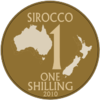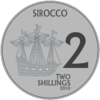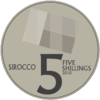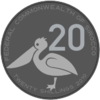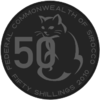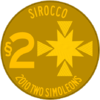Siroccan simoleon
| Simoleon Sirijie (Siroccan) Gured (Edallic) | |||||
|---|---|---|---|---|---|
| |||||
| ISO 4217 | |||||
| Code | SRS | ||||
| Denominations | |||||
| Plural | Simoleons | ||||
| Symbol | § | ||||
| Shilling | ȿ | ||||
| Nickname | Quid | ||||
| Banknotes | §5, §10, §20, §50, §100, §200 | ||||
| Coins | 1ȿ, 2ȿ, 5ȿ, 10ȿ, 20ȿ, 50ȿ, §1, §2 | ||||
| Demographics | |||||
| User(s) | |||||
| Issuance | |||||
| Central bank | Imperial Bank of Sirocco | ||||
| Printer | Imperial Bank of Sirocco | ||||
| Mint | Imperial Bank of Sirocco | ||||
| Valuation | |||||
| Pegged with | NZ$1.60 | ||||
The Simoleon (Siroccan: Sirijie, Edallic: Gured) (sign: §; code: SRS) is the currency of the Federal Commonwealth of Sirocco. It is subdivided into 100 shillings (sign: ȿ). It was created by Premier Daniel Anderson and is printed by the Imperial Bank of Sirocco, in Alston, National Capital District. All coins and banknotes are designed by the Premier.
History
As part of Sirocco's foundation preparations in late 2010, it was decided to adopt the unit of currency, the simoleon, from the SimCity series of games (not from The Sims as commonly thought). Until the country's coins were first issued on December 11, 2010, and the banknotes on February 5, 2011, Sirocco de facto used the New Zealand dollar, which is still accepted nationwide.
After over a year of using the old coins and notes, the Ministry of Finance unveiled the new "2012 series" banknotes on May 16, 2012. The "2012" notes are the first to have their denominations in English, Siroccan and Edallic.
Written styles
Amounts can be written in three different ways: as §.ȿ (known as the Standard Format, written as §5.25ȿ), as § d (known as the Decimal Format, written as §5 2d) or as § /5d (known as the Half-Decimal Format, written as §5 2/5d).

If the amount is less than one Simoleon, its sign (§) is never written (such as §.15ȿ). If the amount is one simoleon or more, its sign is always written (such as §1.15ȿ). The shilling symbol is generally used, but is not compulsory. Amounts over 99ȿ are never written as shilling totals (102ȿ is invalid, §1.02ȿ is to be used instead).
If the shilling count is less than ten, then the zero is omitted (9ȿ instead of 09ȿ), but it may not be removed if it is part of a full simoleon (§1.09 instead of §1.9ȿ).
Standard Format
The Standard Format is the predominant style of writing amounts in Simoleons and shillings, and in some cases the only way of writing it. The style is always used for amounts that do not equal a Decimal or Half-Decimal (such as 52ȿ or §12.16ȿ) but can also be used if the amount does equal a Decimal or Half-Decimal. If the amount is less than one simoleon, the Standard Format is always rendered as xȿ (as in 12ȿ). If the amount is greater than one Simoleon, it is rendered without the shilling symbol.
Decimal Format
The Decimal Format may be used if the shilling total comes to an exact ten shillings. It is, in some cases, a quicker way of writing a total than the Standard Format. Its symbol is a d. If the amount is less than one Simoleon, the Decimal Format is always rendered as xd (as in 1d for 10ȿ). If the amount is greater than one Simoleon, it is rendered as § d (as in §1 1d).
Half-Decimal Format
The Half-Decimal Format is only used for 25ȿ and 75ȿ totals. This format is rarely used but is acceptable. It is written using /5d. It is most often used for totals less than one Simoleon (usually 2/5d is used more than §1.2/5d). If the amount is less than one Simoleon, the Half-Decimal Format is always rendered as /5d (as in 2/5d for 25ȿ). If the amount is greater than one Simoleon, it is rendered as § /5d (as in §1 2/5d for §1.25ȿ).
Banknotes
| Image | Value |
Colour | Description | |||
|---|---|---|---|---|---|---|
|
Obverse |
Reverse | Obverse | Reverse | Date of Issue | ||

|

|
§5 | Pink | John Key, 38th Prime Minister of New Zealand | Dirigible | May 16, 2012 |

|

|
§10 | Gold | Livia Aïrosser, Ambassador to Argentina | SimCity 3000 | |

|

|
§20 | Purple | Chanelle Gibson, Minister of National Services | Tram | |

|

|
§50 | Red | Nicholas Woode-Smith, Shogun of the Dominion of Zona | Flying Toasters | |

|

|
§100 | Green | Jesse Coles, Vice-Premier of Sirocco | Power pole | |

|

|
§200 | Blue | Daniel Anderson, Premier of Sirocco | Douglas DC-3 | |
2010/2011 series
Coins
Banknotes
| Image | Value | Colour | Description | Date of Issue |
|---|---|---|---|---|
| §5 | Grey | Coat of Arms Lion | February 5, 2011 | |
| §10 | Purple | Capital Cross | February 5, 2011 | |
| §20 | Orange | Livia Aïrosser, Minister of Finance | February 5, 2011 | |
| §50 | Yellow | Annabelle Morgan, Minister of Internal Affairs | February 5, 2011 | |
| §100 | Red | Chanelle Gibson, Minister of Health and Education | February 5, 2011 | |
| §200 | Green | Jesse Coles, Vice-Premier | February 5, 2011 | |
| §500 | Blue | Daniel Anderson, Premier | February 5, 2011 |
Exchange Rate
There is no variation in the exchange rate of the Simoleon - once an exchange rate is calculated, both the Simoleon and the currency to be exchanged are pegged together. The Simoleon is also macronationally pegged to the New Zealand dollar at 62.5ȿ to the dollar.
Micronational
- 0.33 Tarvin (§3 to the Tarvin)
- 1.90 Yablokon Kon (53ȿ to the Kon)
- 0.85 Zealandian Krona (§1.18 to the Krona)
Macronational
- 1.60 New Zealand dollars (62ȿ to the dollar)
- 1.49 Australian dollars (67ȿ to the dollar)
- 1.01 United States dollars (99ȿ to the dollar)
- 0.92 euros (§1.09 to the euro)
Cryptocurrency
- 1 Bitcoin = §8,090
New Zealand exchange rate
The following are the values for the New Zealand dollar and the simoleon: (note that values are truncated)
| 0.01 | 0.02 | 0.05 | 0.10 | 0.20 | 0.50 | 1 | 2 | 5 | 10 | 20 | 50 | 100 | 200 | Calculation | |
|---|---|---|---|---|---|---|---|---|---|---|---|---|---|---|---|
| New Zealand dollar to Siroccan simoleon |
§0.006 (0.6ȿ) |
§0.012 (1.2ȿ) |
§0.031 (3.1ȿ) |
§0.062 (6.2ȿ) |
§0.125 (12.5ȿ) |
§0.312 (31.2ȿ) |
§0.625 (62.5ȿ) |
§1.25 | §3.12 | §6.25 | §12.50ȿ (§12 5d) |
§31.25ȿ | §62.50ȿ (§62 5d) |
§125 | $ value ÷ 1.6 |
| Siroccan simoleon to New Zealand dollar |
$0.016 (1.6¢) |
$0.032 (3.2¢) |
$0.08 (8¢) |
$0.16 (16¢) |
$0.32 (32¢) |
$0.80 (80¢) |
$1.60 | $3.20 | $8 | $16 | $32 | $80 | $160 | $320 | § value x 1.6 |
